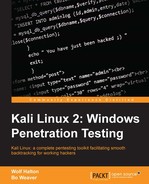In Kali 1.x stress testing was an open topic, but in Kali 2.0 stress testing has been driven off the main menu. Two of the tools from Kali 1.x are gone, DHCPig, and inumdator, but there should be no problem finding a good set of tools in the 2.0 toolbox, nonetheless.

ATK6-Denial6 is an IPv6 network stress-tester that sends packets to a target host and beats it into submission. The first illustration is the help file for ATK6-Denial6.

The next illustration is the nmap -a reading for the vulnerable Windows 7 target machine. We want to find out if it has ports open, and which ports they are. We can see that ports 139, 445, 2869, 5357, and 10243 are open. The big problem with this tool is that the test network is IPv4.

Let's find a tool with which we can attack our IPv4 network.
Siege is a web stress-tester. This is a multithreaded HTTP load testing and benchmarking utility that can show how a web application responds to a ridiculoud load. You can configure the tool to simulate as many users as your hardware can support. It is those users who place the web server "under siege". The output details the performance so you can really dig into the soft spots on an application. Performance measures include the following, which are quantified and reported at the end of each run. Their meaning and significance is discussed below. Siege has essentially three modes of operation:
- Regression (when invoked by bombardment)
- Internet simulation
- Brute force
The formats for using siege are:
siege[options]siege[options][url]siege-g[url]

Siege imitated 15 users going to the website on the Windows 7 target machine. The performance was not all that bad, all in all. There were 8,072 hits on the site in four and a half minutes. The Windows 7 target maintained 100% availability with better than 1/100th of a second response time.
What do you think would happen if we increase the number of besiegers to 10,000? The configuration is at /usr/bin/siege.config. When we run that on the command line, it tells us we already have a local configuration file at /root/siegerc, so let's go look at that:

To edit /root/.siegerc we can use the command line or the gnome launcher Alt + F2 to enter gedit /root/.siegerc or we could find gedit in the Usual Applications Accessories folder, and open the file, open dialog and turn on the hidden files, then find .siegerc in the /root directory. You are probably starting to see the reason Linux administrators like the command line so much.
On line 162 of the configuration file, you will find the number of concurrent users. The current default is 15, but let's change that to 10,000. Let's see if we can crack this baby.

After forcing the Kali instance to close, let's try it with fewer besiegers. The larger the number of concurrent users, the more RAM it uses on your Kali machine, too.

Using 625 besiegers, we got a solid result without crashing the testing machine. In-between, we tested 5,000, 2,500, and 1,250, but they all crashed the machine. If you have a sense of fun, you could test higher numbers, such as 940, 1,090, and so on. The resources available on your testing machine will rule the number of besiegers you can employ.
